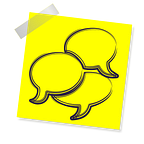How to Make a Podcast
Interested in making a podcast? Our tutor Natalie has written a great guide to getting started!
Hello! So you want to learn how to Podcast? Well you’ve come to the right place.
1). Open up Adobe Audition or Audacity.
The one on the right is Audition and the left is Audacity. If you can’t find either of these on the dock just search for them by clicking the magnifying glass in the top right corner of your screen.
So, what are the differences between the two and which should you use?
➔ If you are just starting out and this is a one-time thing- maybe you have to make a podcast for a project or something of the sort, then I would recommend Audacity. This program is fairly easy on beginners and most people can pick it up quickly, it looks a lot more old school and less daunting than Audition. Another plus is that if you wanted to edit on your own laptop at home, you can download this program for free and edit it there.
➔ If you want to make a weekly, daily, or monthly podcast or if you appreciate a sleek design with lots of features, then I would recommend Audition. This is personally my favorite program and it can seem a little scary to use at first, but it is actually a lot less complicated than it looks. This is a great program to learn, and it’s a terrific resume builder.
If you’re using Audacity, you can start here!
2). Make sure your recording device is plugged in. If it is not plugged in before you open Audacity, it probably will not be able to see your device. You can use a pair of earbuds with a microphone on it or a fancier microphone for better sound quality.
3). Open Audacity. In the top left corner, Click Audacity > Preferences > Input. Select the device you will be speaking into.
4). You can now start recording! To record a new track, just hit the record button (the red circle in the control panel) and start speaking.
○ To add music or prerecorded audio: File > Input > Audio. This should import itself onto a new track.
○ To edit out a bit: Select the track you want to edit. Make sure to save a copy of your track before you do this in case you think it sounded better with the bit. Click the scissor tool (it looks like a pair of scissors cutting through a blue soundwave, it is in the control panel). Select the beginning of the bit you want to cut- this should split the track in half. Now select the end of the bit you want to edit out. The bit should now be isolated. You can now select the bit and delete it.
If you’re using Audition start here!
2). Make sure your recording device is plugged in. If it is not plugged in before you open Audition, it probably will not be able to see your device. You can use a pair of earbuds with a microphone on it or a fancier microphone for better sound quality.
To record onto one track or a ‘waveform’:
3). Open Audition. Create a new audio file.
4). In the control panel click Edit > Preferences > Audio Hardware > Default Stereo Input. Pick the device you will be speaking into.
5). You can now start recording! To record a new track, just hit the record button (the red circle just under the control panel) and start speaking.
To record on a multitrack:
3). Choose File > New > Multitrack session.
4). In the control panel click Edit > Preferences > Audio Hardware > Default Stereo Input. Pick the device you will be speaking into.
5). You can now start recording! To record a new track, just hit the record button (the red circle just under the control panel) and start speaking.
OR if you already started recording on a single audio file, you can select multitrack at the top of the page and move your track to the multitrack.
● In the multitrack you can import ‘multiple tracks’ like music or prerecorded audio. Just go to File > Import > Audio File.
● To slice and remove a bit: Select the Razor blade tool in the toolbar. Select the track you would like to edit. Make sure to save a copy of your track before you do this in case you think it sounded better with the bit. Slice the beginning of the bit you would like to edit out. Then, select the end of the bit. This should isolate the bit from the rest of the track and you can delete it.
Now you know the basics. If you have more questions you can always ask a tutor in the Digital Scholarship Lab. Get recording!
